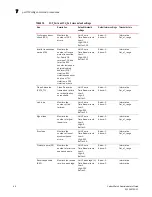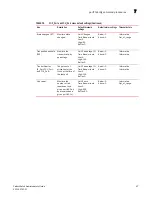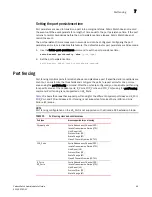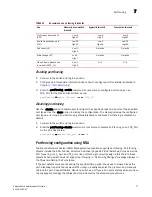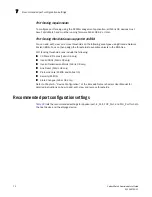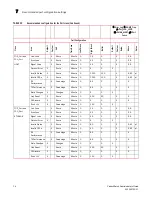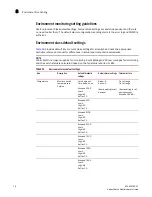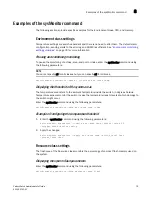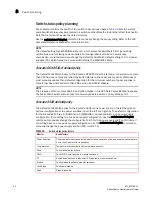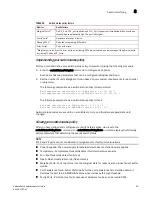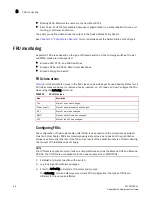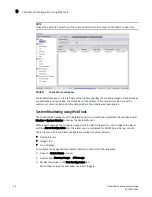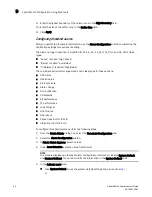
78
53-1002752-01
Fabric Watch Administrator’s Guide
System monitoring using the sysMonitor command
8
System monitoring using the sysMonitor command
Use the sysMonitor command to configure temperature and system resource settings at the
chassis level. For detailed information about the sysMonitor command, refer to the
Fabric OS
Command Reference Manual
.
The following operations are supported by the sysMonitor command:
•
Configure thresholds for Fabric Watch event monitoring and reporting for the environment and
resource classes. Environment thresholds enable temperature monitoring, and resource
thresholds enable monitoring of flash memory.
Configuration changes are saved persistently to non-volatile storage, but the changes do not
take effect until you execute --apply. The --apply option allows you to toggle between default
settings and your own saved custom configuration and to apply actions and thresholds
separately.
•
Configure memory or CPU usage parameters on the switch or display memory or CPU usage.
Configuration options include setting usage thresholds which, if exceeded, trigger a set of
specified Fabric Watch alerts. You can set up the system monitor to poll at certain intervals and
specify the number of retries required before Fabric Watch takes action. Configuring
thresholds for CPU and memory does not follow the transaction model of the typical Fabric
Watch command. The --apply and --cancel options are not valid in this context.
When the system crosses any of the limits, SNMP, RASlog, e-mail (or all) messages are generated.
Flash and temperature configuration are at the chassis level. To execute this command, you must
have chassis-level permission in a virtual fabric (VF) environment.
NOTE
Spikes in memory and CPU utilization are normal during the firmware download process and you
may see threshold warning messages while the process is running. After the firmware download
process has completed, memory and CPU utilization should return to normal.
System monitoring is disabled by default. You must run both the --config -mem and the --config -cpu
commands to enable both memory and CPU system monitoring.
Using the nosave command
The nosave command prevents the configuration changes from being saved persistently. This
option allows you to make and view changes without overwriting the saved configuration.
CAUTION
When you use --config with the --nosave option and the switch reboots, your changes are lost.
Summary of Contents for Fabric Watch
Page 10: ...x Fabric Watch Administrator s Guide 53 1002752 01 ...
Page 12: ...xii Fabric Watch Administrator s Guide 53 1002752 01 ...
Page 14: ...xiv Fabric Watch Administrator s Guide 53 1002752 01 ...
Page 38: ...18 Fabric Watch Administrator s Guide 53 1002752 01 Fabric Watch alarm behavior 2 ...
Page 42: ...22 Fabric Watch Administrator s Guide 53 1002752 01 Fabric Watch classes areas and elements 3 ...
Page 56: ...36 Fabric Watch Administrator s Guide 53 1002752 01 Notification configuration 5 ...



